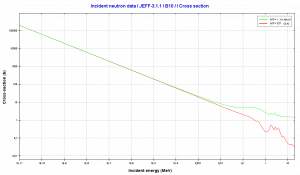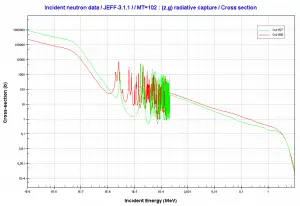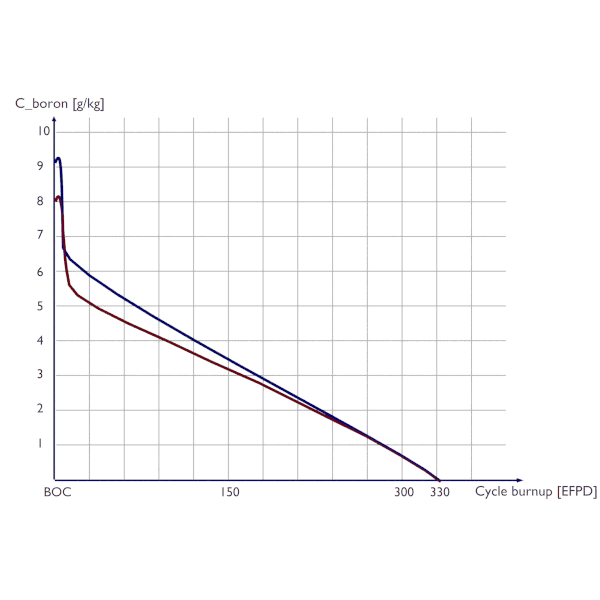Ideally, these absorbers should decrease their negative reactivity while the fuel’s excess positive reactivity is depleted. In PWRs, burnable absorbers are used to decrease the initial concentration of boric acid (also to decrease BOC MTC) and decrease the relative power of fresh fuel assemblies. Fixed burnable absorbers are generally used in the form of compounds of boron or gadolinium that are shaped into separate lattice pins or plates or introduced as additives to the fuel. Since they can usually be distributed more uniformly than control rods, these poisons are less disruptive to the core power distribution.
-

Boron 10. Comparison of total cross-section and cross-section for (n,alpha) reactions.
Source: JANIS (Java-based Nuclear Data Information Software); The JEFF-3.1.1 Nuclear Data LibraryBoron as Burnable Absorber. In the nuclear industry, boron is commonly used as a neutron absorber due to the high neutron cross-section of isotope 10B. Its (n,alpha) reaction cross-section for thermal neutrons is about 3840 barns (for 0.025 eV neutron). Isotope 11B has absorption cross-section for thermal neutrons about 0.005 barns (for 0.025 eV neutron). Most of (n,alpha) reactions of thermal neutrons are 10B(n,alpha)7Li reactions accompanied by 0.48 MeV gamma emission.
 Moreover, isotope 10B has a high (n, alpha) reaction cross-section along the entire neutron energy spectrum. The cross-sections of most other elements become very small at high energies, as in the case of cadmium. The cross-section of 10B decreases monotonically with energy. For fast neutrons, its cross-section is on the order of barns. Boron, as the neutron absorber, has another positive property. The reaction products (after a neutron absorption), helium and lithium, are stable isotopes. Therefore there are minimal problems with decay heating of control rods or burnable absorbers used in the reactor core. On the other hand production of helium may lead to a significant increase in pressure (under rod cladding) when used as the absorbing material in control rods. Moreover, 10B is the principal source of radioactive tritium in the primary circuit of all PWRs (which use boric acid as a chemical shim) because reactions with neutrons can rarely lead to the formation of radioactive tritium via:
Moreover, isotope 10B has a high (n, alpha) reaction cross-section along the entire neutron energy spectrum. The cross-sections of most other elements become very small at high energies, as in the case of cadmium. The cross-section of 10B decreases monotonically with energy. For fast neutrons, its cross-section is on the order of barns. Boron, as the neutron absorber, has another positive property. The reaction products (after a neutron absorption), helium and lithium, are stable isotopes. Therefore there are minimal problems with decay heating of control rods or burnable absorbers used in the reactor core. On the other hand production of helium may lead to a significant increase in pressure (under rod cladding) when used as the absorbing material in control rods. Moreover, 10B is the principal source of radioactive tritium in the primary circuit of all PWRs (which use boric acid as a chemical shim) because reactions with neutrons can rarely lead to the formation of radioactive tritium via:- 10B(n,2x alpha)3H threshold reaction (~1.2 MeV)
- 10B(n,alpha)7Li(n,n+alpha)3H threshold reaction (~3 MeV).
-

Gadolinium 155 and 157. Comparison of radiative capture cross-sections.
Source: JANIS (Java-based Nuclear Data Information Software); The JEFF-3.1.1 Nuclear Data LibraryGadolinium as Burnable Absorber. In the nuclear industry, gadolinium is commonly used as a neutron absorber due to the very high neutron absorption cross-section of two isotopes 155Gd and 157Gd. Their absorption cross-sections are the highest among all stable isotopes. 155Gd has 61 000 barns for thermal neutrons (for 0.025 eV neutron) and 157Gd has even 254 000 barns. For this reason, gadolinium is widely used as a burnable absorber, commonly used in fresh fuel to compensate for an excess of reactivity of reactor core. In comparison with other burnable absorbers, gadolinium behaves like a completely black material. Therefore gadolinium is very effective in compensation of the excess of reactivity. Still, on the other hand, improper distribution of Gd-burnable absorbers may lead to the unevenness of neutron-flux density in the reactor core.
